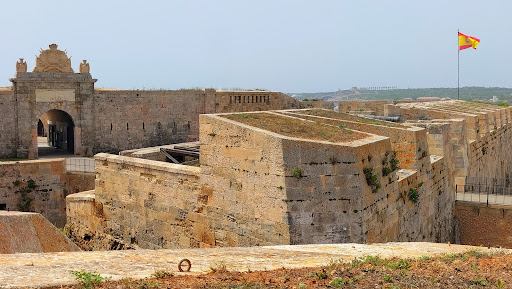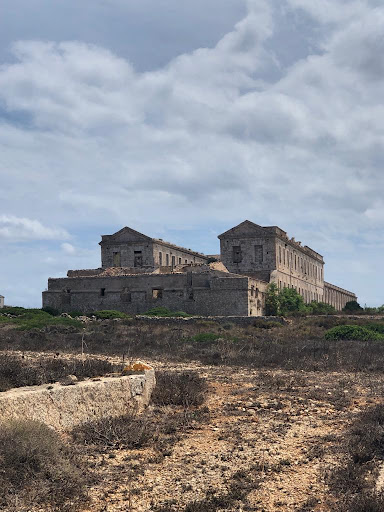This is a must visit place while you are on holiday in Menorca, you need a car to get to the fort complex, you could use a taxi but that would be an expensive option, as far as I could see there wasn't a bus service. There may be arranged coach tours, but you will need to research this. You need to take food and drink with you, though there are a couple of places you can get cold drinks and snacks from vending machines and take shelter from the sun. The Fort is spread over a large area, and will take 3 to four hours (or longer) to fully explore, by foot, or you can hire golf type buggies to drive round, I would recommend doing the tour by foot, there is a lot to see, especially if you like going off track, which you can at your own risk, and there are spectacular viewing points out over the Mediterranean and towards Es Castel and Mahon. Cost of entry, as of August 2017 was 8 euros for adults, slightly cheaper for kids, at the entrance there is a souvenir shop where you can buy good quality goods to remind you of your visit to this wonderful place. If you're into taking photo's, this is a dream place to photograph, there is literally a picture to be taken at every turn, I recommend you take a camera of some type, as close up its very impressive, well preserved and just a joy to photograph, if you're in a group they will have to be patient, while you shoot every perspective that presents itself to the lens. If this is a place you've only seen from a distance, either from a boat trip or from the land, I fully recommend a visit. If you are driving you need to get to the ME3, it's fairly easy to get to, skirt round Mahon, you will end up on the other side of Mahon harbour, follow the ME3, its a longer drive than you might think, eventually you will arrive at the car park, Google Maps will get you there too. Just be aware if it's a hot day, visit here early morning or afternoon after 3pm, take fluids and some food with you, as you will be here for several hours, though as mentioned above, there are a couple of places you can get covered respite from the heat with vending machines. Take plenty of loose change for the vending machines though as they don't take notes. There are machines which will give you change though if you don't have any coins. Enjoy your visit to the forts, its well worth the...
Read moreFantastic place to explore! A lot bigger than I imagined and a great experience overall!
Entrance fee of €8 per adult, got given a map and the lady inside also asked if we wanted her advice (she provided a great insight, recommending what to definitely check out and her suggested route), we explored it all and it was wonderful!
We weren’t aware of an audio tour or the option for golf carts to drive to the canons (we later found out they were a thing but the walk and exploring was enjoyable!). There’s loads of buildings to see, loads of parts of the fort and tunnels etc!
We brought with us a bottle of frozen water that helped as we were there for about 3-4 hours in total. At one or two points though there were vending machines for water and Coca Cola.
As we were down in the tunnels, there was a moment where the electric lights went out and it was just pitch black darkness and silence which felt cool and surreal for a bit, they then came back on - but almost everyone has a flashlight on their phones anyways so it’s fine.
The map provided is adequate for directions and a route, sites to see etc are also well signposted and have information at each relevant section too and on walls...
Read moreLa fortaleza de la Mola es un antiguo complejo militar construido en 1852 con el fin de proteger la bocana del puerto de Maó, construcción que se dilató hasta principios del siglo XX. Esta fortaleza, también, llamada de Isabel II, se encuentra en el punto más oriental de la península, al norte de la ensenada que da acceso al puerto de Maó. Hay un amplio aparcamiento gratuito justo a la entrada de la fortaleza. La entrada general cuesta 8 euros/pax, y se puede alquilar audioguías. La visita se realiza a través de un recorrido que atraviesa por pasadizos, miradores, zonas de defensa y túneles, para lo cual se necesita emplear al menos dos o tres horas de tiempo. Existe la posibilidad de alquilar coches eléctricos, tipo buggy de golf, para aquellas personas con una cierta movilidad reducida o que vayan con niños pequeños. De Mayo a Octubre la fortaleza abre todos los días ininterrumpidamente. A partir de Noviembre conviene ver horarios ya que hay periodos en los que la fortaleza está cerrada. Si la visita se realiza en los meses de verano, es conveniente llevar una gorra o sombrero y alguna botella de agua, ya que, a ciertas horas, hace mucho calor y hay pocas sombras. A lo largo de la historia moderna, Menorca ha sufrido múltiples dominaciones. Los siglos XVIII y XIX fueron extremadamente convulsos en esta isla. En 1713, con el final de la Guerra de Sucesión Española y tras el tratado de Utrecht, Menorca pasa a ser una posesión británica hasta el año 1802 en que, por el tratado de Amiens, vuelve a manos de España. Sin embargo, el siglo XVIII fue un periodo muy agitado en Menorca, ya que la isla cambió de manos en varias ocasiones: de Inglaterra a Francia, España e Inglaterra de nuevo. Debido a todo este convulso periodo y con Inglaterra y Francia en permanente conflicto en el Mediterráneo por la posesión y colonización de diversos territorios en África, es por lo que se decide la construcción de una fortificación en la península de la Mola, que fuera más grande y potente que el derruido castillo de san Felipe, el cual se encontraba en el lado sur de la ensenada. El castillo de san Felipe fue construido en el siglo XVI y destruido por los españoles en 1782, tras la victoria sobre los británicos. A lo largo del siglo XX los avances tecnológicos y militares hicieron que esta fortaleza quedara obsoleta. Así, en los años 30 del pasado siglo XX, se inicia en esta fortaleza el montaje de los enormes cañones Vickers de 381 mm. Se montaron, también, estos cañones en El Ferrol, Cartagena y el estrecho de Gibraltar. En la Mola hay dos cañones que, actualmente, están inutilizados y que son impresionantes de ver por sus dimensiones. Se encuentran situados al final del recorrido. A principios del siglo XX la fortaleza perdió su función defensiva y pasó a ser cuartel militar, prisión y polvorín. En 2007 el Ministerio de Defensa cedió la fortaleza al Govern Balear que es quien gestiona, actualmente, su mantenimiento. La fortaleza está situada en un entorno natural con una especial protección de las aves y otros animales que allí viven. A lo largo del recorrido hay varios miradores desde los que se puede observar la costa este de Menorca y la entrada a la ensenada del puerto de Maó. Merece la pena visitar la fortaleza, un lugar privilegiado con una importante historia y con unas vistas panorámicas fabulosas de los...
Read more


